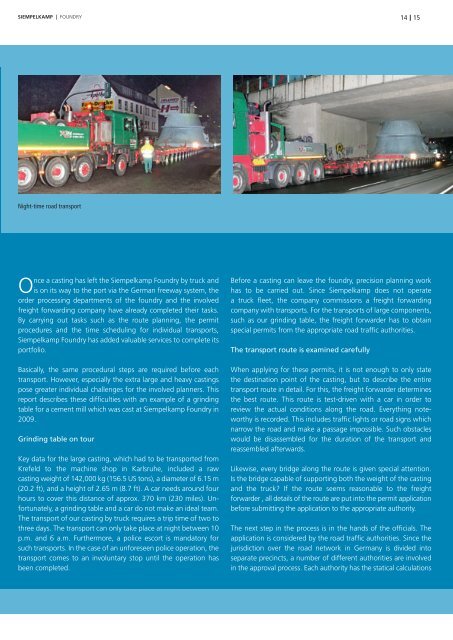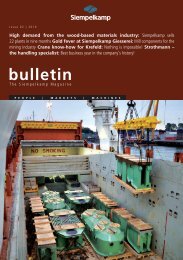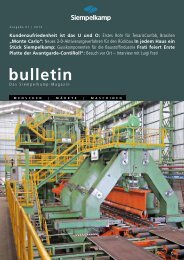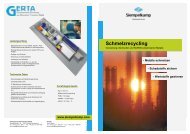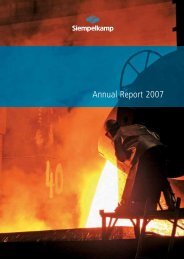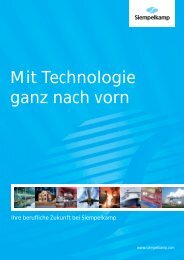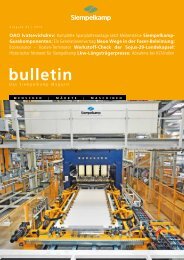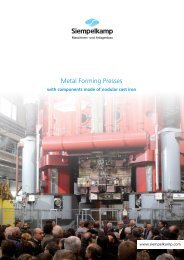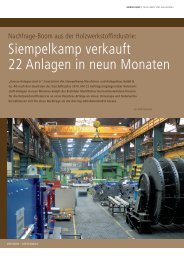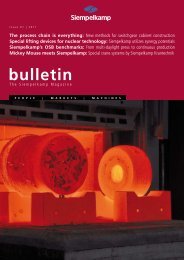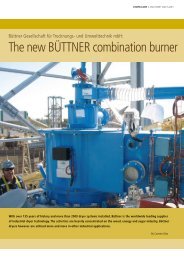Bulletin 1/2010 - Siempelkamp NIS
Bulletin 1/2010 - Siempelkamp NIS
Bulletin 1/2010 - Siempelkamp NIS
Create successful ePaper yourself
Turn your PDF publications into a flip-book with our unique Google optimized e-Paper software.
SIEMPELKAMP | FOUNDRY<br />
Night-time road transport<br />
Once a casting has left the <strong>Siempelkamp</strong> Foundry by truck and<br />
is on its way to the port via the German freeway system, the<br />
order processing departments of the foundry and the involved<br />
freight forwarding company have already completed their tasks.<br />
By carrying out tasks such as the route planning, the permit<br />
procedures and the time scheduling for individual transports,<br />
<strong>Siempelkamp</strong> Foundry has added valuable services to complete its<br />
portfolio.<br />
Basically, the same procedural steps are required before each<br />
transport. However, especially the extra large and heavy castings<br />
pose greater individual challenges for the involved planners. This<br />
report describes these diffi culties with an example of a grinding<br />
table for a cement mill which was cast at <strong>Siempelkamp</strong> Foundry in<br />
2009.<br />
Grinding table on tour<br />
Key data for the large casting, which had to be transported from<br />
Krefeld to the machine shop in Karlsruhe, included a raw<br />
casting weight of 142,000 kg (156.5 US tons), a diameter of 6.15 m<br />
(20.2 ft), and a height of 2.65 m (8.7 ft). A car needs around four<br />
hours to cover this distance of approx. 370 km (230 miles). Unfortunately,<br />
a grinding table and a car do not make an ideal team.<br />
The transport of our casting by truck requires a trip time of two to<br />
three days. The transport can only take place at night between 10<br />
p.m. and 6 a.m. Furthermore, a police escort is mandatory for<br />
such transports. In the case of an unforeseen police operation, the<br />
transport comes to an involuntary stop until the operation has<br />
been completed.<br />
Before a casting can leave the foundry, precision planning work<br />
has to be carried out. Since <strong>Siempelkamp</strong> does not operate<br />
a truck fl eet, the company commissions a freight forwarding<br />
company with transports. For the transports of large components,<br />
such as our grinding table, the freight forwarder has to obtain<br />
special permits from the appropriate road traffi c authorities.<br />
The transport route is examined carefully<br />
When applying for these permits, it is not enough to only state<br />
the destination point of the casting, but to describe the entire<br />
transport route in detail. For this, the freight forwarder determines<br />
the best route. This route is test-driven with a car in order to<br />
review the actual conditions along the road. Everything noteworthy<br />
is recorded. This includes traffi c lights or road signs which<br />
narrow the road and make a passage impossible. Such obstacles<br />
would be disassembled for the duration of the transport and<br />
reassembled afterwards.<br />
Likewise, every bridge along the route is given special attention.<br />
Is the bridge capable of supporting both the weight of the casting<br />
and the truck? If the route seems reasonable to the freight<br />
forwarder , all details of the route are put into the permit application<br />
before submitting the application to the appropriate authority.<br />
The next step in the process is in the hands of the offi cials. The<br />
application is considered by the road traffi c authorities. Since the<br />
jurisdiction over the road network in Germany is divided into<br />
separate precincts, a number of different authorities are involved<br />
in the approval process. Each authority has the statical calculations<br />
14<br />
15


